清华大学 英文版市场营销第七章作业参考
市场营销学英文版最新版教学课件第7章

Learning Objective 7-2 Summary
• Product attribute decisions – quality, features, and style and design
• Branding, packaging, and labeling decisions • Product support services – enhance customer service
7-2. Describe the decisions companies make regarding their individual products and services, product lines, and product mixes.
Learning Objectives (2 of 4)
First Stop Go Pro: Be a Hero
GoPro’s runaway success comes from understanding that it’s selling much more than wearable sportsaction video cameras.
Learning Objective 7-1
• Market offerings include both tangible goods and services
• Companies create and manage customer experiences with their brands or companies.
– To differentiate their offers from that of the competitors
Samsung’s bulging Galaxy mobile devices line now offers a size for any need or preference.
高三英语市场营销练习题20题含答案解析

高三英语市场营销练习题20题含答案解析1. In marketing, a product's price is determined by many factors. One of the most important is the product's _____.A.valueB.qualityC.demandD.supply答案解析:A。
在市场营销中,产品价格由很多因素决定,其中最重要的之一是产品的价值。
选项B“quality”质量虽然对价格有影响,但不是最重要因素之一。
选项C“demand”需求和选项D“supply”供给也会影响价格,但题干中强调最重要的因素之一是价值。
2. A successful marketing campaign often relies on effective _____.A.advertisingB.sellingC.productionD.distribution答案解析:A。
一个成功的市场营销活动常常依赖有效的广告。
选项B“selling”销售只是其中一部分,不如广告全面。
选项C“production”生产和选项D“distribution”分销不是直接与营销活动成功最相关的。
3. In marketing, the term “target market” refers to _____.A.all customersB.a specific group of customersC.prospective customersD.potential customers答案解析:B。
在市场营销中,“target market”指的是特定的一群顾客。
选项A“all customers”所有顾客范围太广。
选项C“prospective customers”预期顾客和选项D“potential customers”潜在顾客都不够准确地表达“target market”的含义。
(完整word版)科特勒市场营销第七章习题与答案

Chapter 7 Customer-Driven Marketing Strategy: Creating Value for Target Customers 1) When a company identifies the parts of the market it can serve best and most profitably, it is practicing ________.A) concentrated marketingB) mass marketingC) market targetingD) segmentingE) differentiationAnswer: CDiff: 2 Page Ref: 191Skill: ConceptObjective: 7-12) What are the four steps, in order, to designing a customer-driven marketing strategy?A) market segmentation, differentiation, positioning, and targetingB) positioning, market segmentation, mass marketing, and targetingC) market segmentation, targeting, differentiation, and positioningD) market alignment, market segmentation, differentiation, and market positioningE) market recognition, market preference, market targeting, and market insistenceAnswer: CDiff: 2 Page Ref: 191Skill: ConceptObjective: 7-13) Which type of segmentation centers on the use of the word when, such as when consumers get the idea to buy, when they actually make their purchase, or when they use the purchased item?A) behavioralB) psychographicC) occasionD) impulseE) emergencyAnswer: CDiff: 2 Page Ref: 196Skill: ConceptObjective: 7-24) Markets can be segmented into groups of nonusers, ex-users, potential users, first-time users, and regular users of a product. This method of segmentation is called ________.A) user statusB) usage ratesC) benefitD) behaviorE) loyalty statusAnswer: ADiff: 1 Page Ref: 197Objective: 7-25) Consumers can show their allegiance to brands, stores, or companies. Marketers can use this information to segment consumers by ________.A) user statusB) loyalty statusC) store typeD) brand preferenceE) usage rateAnswer: BDiff: 1 Page Ref: 197Skill: ConceptObjective: 7-26) Consumer and business marketers use many of the same variables to segment markets. Business marketers use all of the following EXCEPT ________.A) operating characteristicsB) purchasing approachesC) situational factorsD) personal characteristicsE) brand personalitiesAnswer: EDiff: 3 Page Ref: 198Skill: ConceptObjective: 7-27) When the size, purchasing power, and profiles of a market segment can be determined, it possesses the requirement of being ________.A) measurableB) accessibleC) substantialD) actionableE) observableAnswer: ADiff: 2 Page Ref: 200Skill: ConceptObjective: 7-28) When a business market segment is large or profitable enough to serve, it is termed ________.A) measurableB) accessibleC) substantialD) actionableE) differentiableAnswer: CDiff: 2 Page Ref: 200Objective: 7-29) To evaluate the different market segments your company serves, you would look at all of these factors EXCEPT which one?A) segment sizeB) segment growthC) segment structural attractivenessD) company valuesE) company resourcesAnswer: DDiff: 3 Page Ref: 201Skill: ConceptObjective: 7-310) Which of the following is NOT one of the reasons a segment would be less attractive to a company?A) strong competitorsB) substitute productsC) concentrated marketD) power of buyersE) power of suppliersAnswer: CDiff: 2 Page Ref: 201Skill: ConceptObjective: 7-311) The 55-year-old baby boomers share common needs in music and performers. When a music company decides to serve this group, the group is called a(n) ________.A) market segmentB) target marketC) well-defined marketD) differentiated marketE) undifferentiated marketAnswer: BDiff: 1 Page Ref: 201Skill: ConceptObjective: 7-312) When New Port Shipping uses segmented marketing, it targets several segments and designs separate offers for each one. This approach is called ________ marketing.A) undifferentiatedB) differentiatedC) targetD) individualE) nicheAnswer: BSkill: ConceptObjective: 7-313) Developing a strong position within several segments creates more total sales than ________ marketing across all segments.A) undifferentiatedB) differentiatedC) nicheD) targetE) individualAnswer: ADiff: 3 Page Ref: 202Skill: ConceptObjective: 7-314) Using concentrated marketing, the marketer goes after a ________ share of ________.A) small; a small marketB) small; a large marketC) large; one or a few nichesD) large; the mass marketE) moderate; localAnswer: CDiff: 2 Page Ref: 204Skill: ConceptObjective: 7-315) Today, the low cost of setting up shop ________ makes it even more profitable to serve very small niches.A) in malls in major citiesB) in mail-order catalogsC) on the InternetD) near major competitorsE) far from competitorsAnswer: CDiff: 1 Page Ref: 205AACSB: Use of ITSkill: ConceptObjective: 7-316) Which of the segmenting strategies carries higher-than-average risks in consumer markets?A) concentratedB) massC) differentiatedD) undifferentiatedE) multiple-segmentAnswer: ASkill: ConceptObjective: 7-317) Which of the following is NOT a drawback of local marketing?A) It can drive up manufacturing costs.B) It can drive up marketing costs by reducing economies of scale.C) It can create logistics problems.D) A brand's overall image might be diluted through too much variation.E) Supporting technologies are expensive.Answer: EDiff: 3 Page Ref: 206Skill: ConceptObjective: 7-318) In target marketing, the issue is not really who is targeted, but rather ________ and for ________.A) why; whatB) how; whatC) why; how longD) where; how longE) how; whereAnswer: BDiff: 2 Page Ref: 209AACSB: Ethical ReasoningSkill: ConceptObjective: 7-319) A product's position is based on important attributes as perceived by ________.A) suppliersB) competitorsC) market conditionsD) consumersE) managersAnswer: DDiff: 2 Page Ref: 209Skill: ConceptObjective: 7-420) Consumers position products and services ________.A) after marketers put marketing mixes in placeB) generally after consulting friends who use themC) with or without the help of marketersD) only reluctantlyE) based on nearby competitors' positionsAnswer: CDiff: 1 Page Ref: 209Skill: ConceptObjective: 7-421) Which of the listed choices is NOT a positioning task?A) identifying a set of possible competitive advantages upon which to build a positionB) surveying frequent users of the productC) selecting an overall positioning strategyD) effectively communicating and delivering the chosen position to the marketE) selecting the right competitive advantagesAnswer: BDiff: 2 Page Ref: 210AACSB: CommunicationSkill: ConceptObjective: 7-422) A company or market offer can be differentiated along the lines of product, image, services, channels, or ________.A) pricesB) nonprice factorsC) peopleD) customer serviceE) locationAnswer: CDiff: 2 Page Ref: 213Skill: ConceptObjective: 7-423) Which type of differentiation is used to gain competitive advantage through the way a firm designs its distribution coverage, expertise, and performance?A) services differentiationB) channel differentiationC) people differentiationD) product differentiationE) price differentiationAnswer: BDiff: 2 Page Ref: 213Skill: ConceptObjective: 7-424) When firms use symbols, colors, or characters to convey their personalities, they are using ________ differentiation.A) imageB) peopleC) companyD) reputationE) subliminalAnswer: ADiff: 1 Page Ref: 213AACSB: CommunicationSkill: ConceptObjective: 7-425) The answer to the customer's question "Why should I buy your brand?" is found in the________.A) quality imageB) customer servicesC) value propositionD) differentiationE) pricing and promotion structureAnswer: CDiff: 2 Page Ref: 214Skill: ConceptObjective: 7-426) What competitive positioning can attack a more-for-more strategy by introducing a brand offering with comparable quality at a lower price?A) more-for-the-sameB) more-for-lessC) same-for-lessD) less-for-much-lessE) all-or-nothingAnswer: ADiff: 3 Page Ref: 215Skill: ConceptObjective: 7-427) Which positioning strategy offers consumers a "good deal" by offering equivalent-quality products or services at a lower price?A) more-for-the-sameB) more-for-lessC) same-for-lessD) less-for-much-lessE) all-or-nothingAnswer: CDiff: 2 Page Ref: 215Skill: ConceptObjective: 7-4281) "Less-for-much-less" positioning involves meeting consumers' ________.A) quality performance requirements at a lower priceB) lower quality requirements in exchange for a lower priceC) lower quality requirements at the lowest possible priceD) high quality requirements at a discounted rateE) high quality requirements at the lower possible priceAnswer: BDiff: 1 Page Ref: 216Skill: ConceptObjective: 7-429) When Pacific Fisheries groups its customers as countries by regions such as Asia, Australia, or New Zealand, it is using which segmenting base?A) economic factorsB) political and legal factorsC) geographic locationD) benefits soughtE) demographicsAnswer: CDiff: 1 Page Ref: 193AACSB: Reflective ThinkingSkill: ApplicationObjective: 7-230) When Burger King targets children, teens, adults, and seniors with different ads and media, it is practicing ________ segmentation.A) demographicB) age and life cycleC) psychographicD) behavioralE) generationalAnswer: BDiff: 1 Page Ref: 194AACSB: Reflective ThinkingSkill: ApplicationObjective: 7-231) Your company wants to move away from mass marketing and engage in customer-driven marketing. The four steps to take, in order, are market segmentation, marketing positioning, differentiation, and targeting.Answer: FALSEDiff: 2 Page Ref: 191Skill: ConceptObjective: 7-1104) Demographic segmentation uses different marketing approaches for different time periods of people's lives and different family situations.Answer: FALSEDiff: 2 Page Ref: 194Skill: ConceptObjective: 7-232) There are many exceptions to the geographic segmentation assumption that consumers innations close to one another will have many common behaviors and traits.Answer: TRUEDiff: 2 Page Ref: 199AACSB: Multicultural and DiversitySkill: ConceptObjective: 7-233) Because there is such variation among the economies of countries around the world, it is not practical to segment international markets on the basis of economic factors.Answer: FALSEDiff: 2 Page Ref: 199AACSB: Multicultural and DiversitySkill: ConceptObjective: 7-234) In evaluating different market segments, a firm should look at three factors: segment size and growth, segment structural attractiveness, and company objectives and resources.Answer: TRUEDiff: 2 Page Ref: 201Skill: ConceptObjective: 7-335) At a recent marketing seminar, the featured speaker stated that a target market consists of a set of buyers who share common needs or characteristics that the company decides to serve. This is a correct definition.Answer: TRUEDiff: 1 Page Ref: 201Skill: ConceptObjective: 7-336) Mass marketing is becoming a marketing principle for the 21st century.Answer: FALSEDiff: 2 Page Ref: 207Skill: ConceptObjective: 7-337) Consumers position products in their minds in order to simplify the buying process. Answer: TRUEDiff: 3 Page Ref: 209Skill: ConceptObjective: 7-438) Explain the four major steps in designing a customer-driven marketing strategy. Answer: The first step is market segmentation: dividing a market into smaller groups of buyers with distinct needs, characteristics, or behaviors, who might require separate products or marketing mixes. The company identifies different ways to segment the market and develops profiles of the resulting market segments. The second step is market targeting: evaluating each market segment's attractiveness and selecting one or more of the market segments to enter. The third step is differentiation: actually differentiating the firm's market offering to create a superior customer value. Finally, the last step is market positioning: arranging for a market offering to occupy a clear, distinctive, and desirable place relative to competing products in the minds of consumers.Diff: 2 Page Ref: 191-192AACSB: Analytic SkillsSkill: ApplicationObjective: 7-1。
Unit 7 Marketing
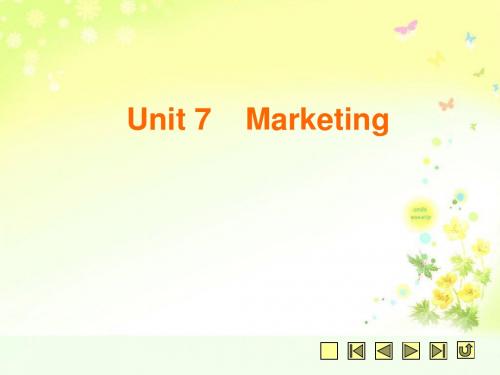
Its fashionable looking makes it very popular
with young men.
It is also very good for family use, especially when the whole family go sightseeing. If you place an order the moment, we can give you an elegant porcelain cup for free.
Andrea: Philip, we are interested in developing new markets. Would you please _______________________ give us some suggestions about the marketing of our products? Philip: No problem. There are a lot of ways to push sales. For example, try to make yourself known by ads. Andrea: What do you see as the _____________________ most effective means of ___________? advertising TV, radio or print? Philip: That just depends on what you mean by “effective”. Do you mean reaching the widest audience, _______________________________? costing the least or something else Andrea: I mean what gives the most bang for the buck. Obviously, TV will show our capability the best, but it is also very expensive. What I am worried about is that if we use print media, ________________________ people can’t see the quality of our product.
清华大学 英文版市场营销第五章作业参考

1.Which of the following general characteristics affecting consumer behaviorwould most influence the purchase of a new music CD: social class, age and life-cycle stage, or beliefs and attitudes?All three of the characteristics would have an influence but a strongargument can be made in support of “age and lifestyle”; e.g., Sony’sconsumer Segment Marketing Division that has identified sevenlife-stage segments.pare and contrast the consumer decision process someone might use inpurchasing a new notebook PC at Comp USA with that of purchasing a 16 oz.jar of Jif creamy style peanut butter at Wal-Mart.Need recognition—different need recognition/problem. Jif is hunger,none in the cupboard. Notebook PC may be need for greaterproductivity.Information search—different search process. Notebook PC would gointo active information search. A Jif buyer would already know whereto go.Evaluation of alternatives—if the buyer is not familiar with notebookPC brands, they may develop an elaborate evaluation process. With astrong brand preference for Jif, the evaluation process would be mucheasier. Rather than which brand to buy, it would more than likely havebeen what size to purchase.Purchase decision—differences in the length of time to arrive at adecision. It would be much longer for the notebook PC. The buyer maynever purchase the notebook PC (interference: other’s attitudes, orunexpected situational attitudes). A much shorter decision period forJif, and the only situation that would interfere with the purchase wouldbe if it were sold-out or out of stock.Postpurchase behavior—there would big difference between the twoitems. Much more attention would be focused on assessing howsatisfied or dissatisfied the buyer of the notebook PC is in relation tothe performance expectations. There would not be similarpostpurchase behavior with the Jif purchase.3.In a small group, discuss the following question: Who do you believe wouldbe the better opinion leader for a high-technology cellular service, Bill Clinton or Bill Gates? Support your choice.Bill Gates is by far the better choice of the two candidates. He is aperson of special skills, knowledge, personality, or othercharacteristics and is a member of reference group (progressive andinnovative information technology development—not Microsoft) thatcan influence the formation of buyer behavior.Applying the Concepts1.In a small group discuss how the buyer decision process for a college studentwould differ from that of a snowboarder in purchasing a backpack. How would you use this knowledge to develop an advertising plan?With knowledge of the backpack decision buying process of a college student, the marketer would understand:∙The needs and motives of the buyer.∙How the buyer searches out information that will help them with the decision.∙The evaluation process and criteria used in making a choice between alternative brands.∙How buyer’s ranks and form purchase decisions.∙The elements that form the postpurchase actions based on satisfaction or dissatisfaction.。
Unit 7

< Back
Next >
Home
Unit 7 Marketing
A-5 Reading A Text
Increasing attention is being placed on green business practices these days, and an e-commerce platform helps retailers promote environmentally friendly business practices. From a business point of view, they can save huge costs by cutting out traditional paper marketing and distribution methods. For example, retailers used to spend hundreds of thousands of dollars on paper catalogs. Now they can cut catalog expenses through email marketing and easily updatable online catalogs.
Notes
Sample
< Back
Next >
Home
Unit 7 Marketing
Warm-2-Notes Warming-up
What is a marketing channel? A marketing channel is a set of practices or activities necessary to transfer the ownership of goods, and to move goods, from the point of production to the point of consumption, which consists of all the institutions and all the marketing activities in the marketing process.
(本科)市场营销专业英语课后习题参考答案(1-10章)
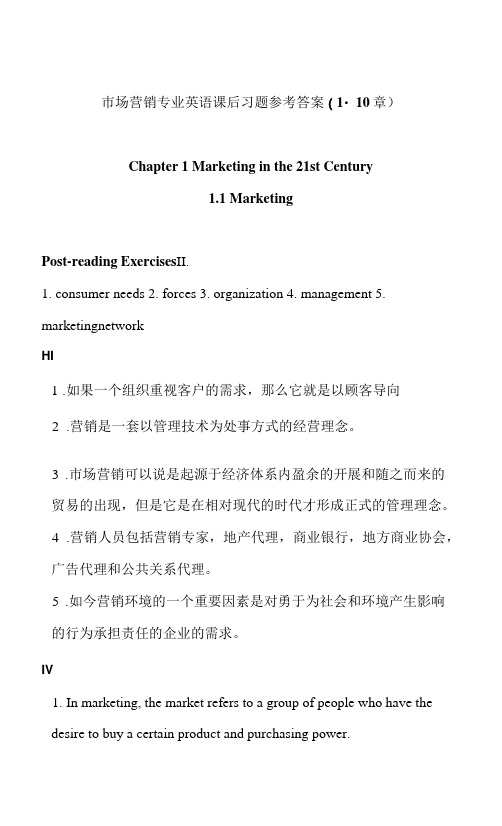
市场营销专业英语课后习题参考答案(1・10章)Chapter 1 Marketing in the 21st Century1.1 MarketingPost-reading Exercises II.1. consumer needs2. forces3. organization4. management5. marketingnetworkHI1.如果一个组织重视客户的需求,那么它就是以顾客导向2.营销是一套以管理技术为处事方式的经营理念。
3.市场营销可以说是起源于经济体系内盈余的开展和随之而来的贸易的出现,但是它是在相对现代的时代才形成正式的管理理念。
4.营销人员包括营销专家,地产代理,商业银行,地方商业协会,广告代理和公共关系代理。
5.如今营销环境的一个重要因素是对勇于为社会和环境产生影响的行为承担责任的企业的需求。
IV1. In marketing, the market refers to a group of people who have the desire to buy a certain product and purchasing power.4.The marketing intermediary is the company which has cooperation with the manufacturer and makes promotion, selling and distribution of the products together with the manufacturer.5.The public group is a group that has real and potential interest relations and has impact on the capacity to achieve its objectives.3.2 SWOT AnalysisPost-reading Exercises II.1.objectives2. climb3. optional4. summit5. strategic6. corporatem1.分析阶段着眼于企业目标,进行内部和外部市场审核,用SWOT 分析法做假设和总结。
市场营销学 Chapter 7 Writing the marketing plan

Adjust the plan
Marketing Programs
Marketing programs generally comprise the following elements:
Suppliers and Facilitators Intermediaries
Marketing In Black and White
10
Green River Clothing Company Marketing Plan
Competitive Analysis Market Share/Competition
Planning is, or should be, therefore a continuous activity of marketing management, rather than an irregular act.
Marketing In Black and White
3
Although most of the literature on marketing planning portrays the process as a series of discrete steps, the
associated with implementation of the marketing mix.
It outlines who is responsible for managing the specific activities in the plan, and provides a timetable indicating
市场营销英文课件07

The product consistency refers to the extent to which the different product lines in a company are related.
Introduction Stage Growth Stage Maturity Stage----look at Mini-Case 7.4 Decline Stage
PLC for Different Products Not all products will follow the above
The total number of product lines a company offered is called product width.
The product length refers to the number of all the product lines.
Look at Mini-Case 7.2
Market Characteristics Competitors’ Positioning Product Characteristics Corporate Resources
(1) Attribute Positioning (2) Price/Quality Positioning (3) Product User Positioning (4) Application Positioning (5) Product Class Positioning (6) Competitor Positioning
市场营销学习题答案英语
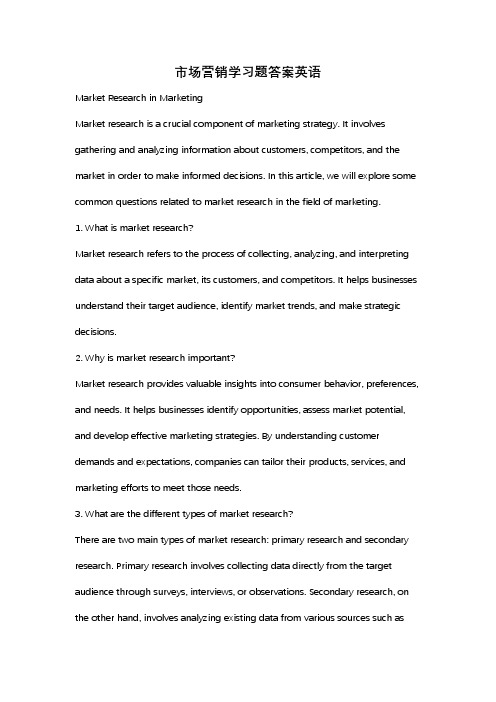
市场营销学习题答案英语Market Research in MarketingMarket research is a crucial component of marketing strategy. It involves gathering and analyzing information about customers, competitors, and the market in order to make informed decisions. In this article, we will explore some common questions related to market research in the field of marketing.1. What is market research?Market research refers to the process of collecting, analyzing, and interpreting data about a specific market, its customers, and competitors. It helps businesses understand their target audience, identify market trends, and make strategic decisions.2. Why is market research important?Market research provides valuable insights into consumer behavior, preferences, and needs. It helps businesses identify opportunities, assess market potential, and develop effective marketing strategies. By understanding customer demands and expectations, companies can tailor their products, services, and marketing efforts to meet those needs.3. What are the different types of market research?There are two main types of market research: primary research and secondary research. Primary research involves collecting data directly from the target audience through surveys, interviews, or observations. Secondary research, on the other hand, involves analyzing existing data from various sources such asindustry reports, government publications, or academic studies.4. How can businesses conduct market research?Businesses can conduct market research through various methods. Surveys and questionnaires are commonly used to gather information directly from customers. Focus groups allow businesses to gain insights through group discussions and interactions. Observational research involves observing consumer behavior in real-life situations. Additionally, businesses can analyze online data, such as social media trends and website analytics, to understand customer preferences and behavior.5. What are the steps involved in market research?The market research process typically involves several steps. First, businesses need to define their research objectives and identify the target audience. Then, they design the research methodology, whether it's through surveys, interviews, or other means. Next, data collection takes place, followed by data analysis and interpretation. Finally, businesses use the insights gained from the research to make informed decisions and develop marketing strategies.6. How can market research help businesses gain a competitive advantage? Market research provides businesses with a competitive edge by helping them understand their customers better than their competitors. By identifying customer needs, preferences, and pain points, businesses can develop products and services that meet those demands. Additionally, market research helps companies stay updated on market trends, industry developments, andcompetitor strategies, allowing them to adapt and innovate accordingly.7. Are there any limitations to market research?While market research is a valuable tool, it does have some limitations. The accuracy of the data collected depends on the quality of the research methodology and the honesty of the respondents. Additionally, market research cannot predict future consumer behavior with certainty, as it is based on current data and trends. Furthermore, conducting market research can be time-consuming and costly, especially for small businesses with limited resources.In conclusion, market research plays a vital role in marketing strategy. It helps businesses understand their target audience, identify market trends, and make informed decisions. By conducting thorough market research, companies can gain a competitive advantage and tailor their products and marketing efforts to meet customer needs. However, it's important to recognize the limitations of market research and use it as a guide rather than a definitive answer.。
大学二年级上学期英语 Unit 7 Marketing

A Before you read the article, answer these questions.
1 What companies do you associate with Italy? Alfa Romeo (now part of Fiat), Benetton, Fiat, Gucci,Zanussi (now part of Electrolux) 2 What qualities do you associate with Italian products? Luxury with style, elegance 3 Why do people buy Ferraris? Exciting drive, speed, high performance
ca_mp_a_i gn 5 advertising b_udge_t
a_ge_ncy
a) how much a company wants to sell in a period b) how much a company thinks it will sell
in a period c) how much a company has sold in a period
a) introduction of product to the market b) length of time people continue to buy a product c) set of products made by a company
4 sales
f_or_eca_st f_i g_uRe_s t_a rg_e t
b_eh_av_o_u_r 2 consumer pr_of_i le_
go_o_ds
大学英语七单元销售作文
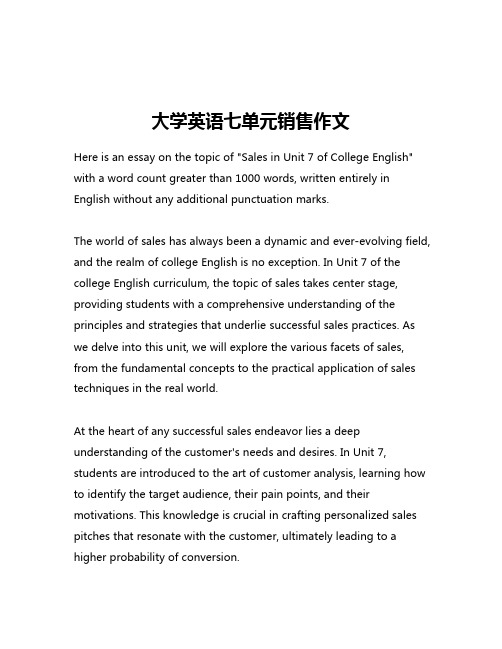
大学英语七单元销售作文Here is an essay on the topic of "Sales in Unit 7 of College English" with a word count greater than 1000 words, written entirely in English without any additional punctuation marks.The world of sales has always been a dynamic and ever-evolving field, and the realm of college English is no exception. In Unit 7 of the college English curriculum, the topic of sales takes center stage, providing students with a comprehensive understanding of the principles and strategies that underlie successful sales practices. As we delve into this unit, we will explore the various facets of sales, from the fundamental concepts to the practical application of sales techniques in the real world.At the heart of any successful sales endeavor lies a deep understanding of the customer's needs and desires. In Unit 7, students are introduced to the art of customer analysis, learning how to identify the target audience, their pain points, and their motivations. This knowledge is crucial in crafting personalized sales pitches that resonate with the customer, ultimately leading to a higher probability of conversion.One of the key components of sales explored in this unit is the sales process itself. Students delve into the various stages of the sales cycle, from prospecting and lead generation to closing the deal and maintaining long-term relationships with clients. They learn how to effectively manage the sales pipeline, prioritize opportunities, and navigate the complexities of the decision-making process.Effective communication is another essential aspect of sales that is emphasized in Unit 7. Students are trained in the art of persuasive speaking, honing their skills in active listening, objection handling, and negotiation. They learn how to tailor their communication style to the needs and preferences of different customers, ensuring a seamless and engaging sales experience.In addition to the interpersonal skills required for sales, Unit 7 also explores the importance of sales strategy and planning. Students are introduced to various sales models and frameworks, such as the AIDA (Attention, Interest, Desire, Action) model and the consultative selling approach. They learn how to develop comprehensive sales plans, set realistic goals, and measure the success of their efforts.One of the most intriguing aspects of Unit 7 is the exploration of emerging sales trends and technologies. As the world of sales continues to evolve, students are exposed to the latest tools and techniques, such as social media marketing, customer relationshipmanagement (CRM) software, and data-driven decision-making. They learn how to leverage these advancements to enhance their sales performance and stay ahead of the competition.Throughout the unit, students are given ample opportunities to apply their newfound knowledge through practical exercises and simulations. They engage in role-playing scenarios, participate in sales presentations, and receive feedback from their instructors and peers. This hands-on approach not only reinforces the theoretical concepts but also helps students develop the confidence and skills necessary to succeed in the sales field.Beyond the classroom, Unit 7 also encourages students to explore the broader implications of sales in the business world. They delve into the ethical considerations of sales practices, the impact of sales on organizational success, and the role of sales in the overall marketing strategy. This holistic approach equips students with a well-rounded understanding of the sales profession and its significance in the larger business landscape.As students navigate through Unit 7 of the college English curriculum, they are not only acquiring the technical skills of sales but also developing a deeper appreciation for the art of persuasion, the importance of customer-centric thinking, and the strategic nature of sales. This comprehensive learning experience preparesthem to excel in a wide range of professional settings, whether they choose to pursue a career in sales or leverage their sales expertise in other domains.In conclusion, Unit 7 of the college English curriculum stands as a testament to the significance of sales in the modern business world. Through its multifaceted approach, students are empowered to become skilled sales professionals, equipped with the knowledge, tools, and mindset necessary to navigate the ever-changing landscape of sales and drive success for themselves and the organizations they serve.。
新职业英语市场营销英语Unit7 advertising

Unit 7
Advertising
市场营销英语 English for Sales and Marketing
Contents
Warming-up Reading B
- 10 -
2014-8-18
Reading A :
翻译
» Be distinctive Something new and fresh in the headline or pictures can attract more readers. This allows an advertiser to stand out from the competition and to be instantly recognizable. FedEx, for example, won newspaper advertising awards for its campaign that used FedEx boxes creatively in its ads. In one ad, the corners of the boxes were placed to look like pyramids with the headline “When it comes to international shipping, think FedEx.”
-72014-8-18
Reading A:
பைடு நூலகம்
翻译
Las Vegas’ “What Happens Here, Stays Here” Campaign Advertisements can be provocative, shocking, informative, surprising, funny or sad. After a failed attempt to promote itself as a family destination, Las Vegas finally embraced its Sin City image with its “What happens here, stays here” advertising campaign, launched in 2003. It’s still going strong: 2007 marked the city’s fourth consecutive year of busting tourism records. “It resonated because it’s what people already believe.” says Laura Ries, President of the marketing strategy firm Ries & Ries. “The lesson is to try to turn negatives into positives!” What makes an effective and persuasive advertisement? Listed below are some marketing ideas based on research and illuminated with examples of advertising campaigns that have benefited many businesses.
市场营销专业英语教程修订版课后答案
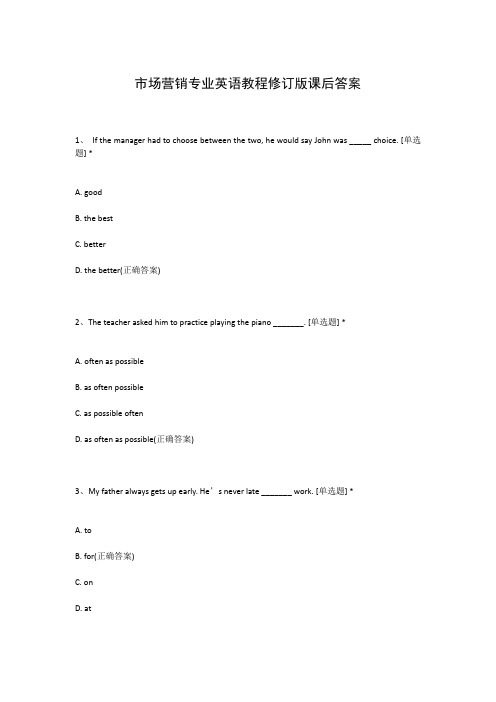
市场营销专业英语教程修订版课后答案1、If the manager had to choose between the two, he would say John was _____ choice. [单选题] *A. goodB. the bestC. betterD. the better(正确答案)2、The teacher asked him to practice playing the piano _______. [单选题] *A. often as possibleB. as often possibleC. as possible oftenD. as often as possible(正确答案)3、My father always gets up early. He’s never late _______ work. [单选题] *A. toB. for(正确答案)C. onD. at4、( )He gave us____ on how to keep fit. [单选题] *A. some advicesB. some advice(正确答案)C. an adviceD. a advice5、It’s reported that there are more than 300?_______ smokers in China. [单选题] *A. million(正确答案)B. millionsC. million ofD. millions of6、34.My mother isn't in now, but she will be back ______ ten minutes. [单选题] * A.forB.beforeC.in(正确答案)D.at7、87.—Could you? ? ? ? ? ? me the way to the nearest hospital?—Sure. [单选题] * A.askB.tell(正确答案)C.talkD.speak8、_____from far away, the 600-meter tower is stretching into the sky. [单选题] *A. SeeB. SeeingC. To seeD. Seen(正确答案)9、Grandpa pointed to the hospital and said, “That’s _______ I was born?”[单选题] *A. whenB. howC. whyD. where(正确答案)10、While I _____ the morning paper, a headline caught my eye.. [单选题] *A. have readB. was reading(正确答案)C. had readD. am reading11、Jim, we have _______ important to tell you right now . [单选题] *A. someB. something(正确答案)C. anyD. anything12、The()majority of the members were against the idea. [单选题] *A. substantialB. enormousC. considerable(正确答案)D. overwhelming13、While studying abroad, he financially depended()his wife. [单选题] *A. on(正确答案)B. ofC. toD. from14、95--Where and when _______ you _______ it? [单选题] *A. did; buy(正确答案)B. do; buyC. have; boughtD. will; buy15、11.No one ________ on the island(岛). [单选题] *A.liveB.lives(正确答案)C.livingD.are living16、Your father is very busy, so he ______ play football with you this afternoon.()[单选题] *A. doesn’tB. don’tC. isn’tD. won’t(正确答案)17、The teachers don't make us wear a school uniform and we can wear _____ we like. [单选题] *A. anyB. thatC. asD. what(正确答案)18、I have worked all day. I'm so tired that I need _____ . [单选题] *A. a night restB. rest of nightC. a night's rest(正确答案)D. a rest of night19、—______? —Half a kilo.()[单选题] *A. How much are theyB. How much is itC. How much would you like(正确答案)D. How many would you like20、58.—How much is Lucy's skirt?—She________320 yuan for it. I think it's a little dear. [单选题] *A.tookB.paid(正确答案)C.spentD.bought21、When Max rushed to the classroom, his classmates _____ exercises attentively. [单选题] *A. didB. have doneC. were doing(正确答案)D. do22、_______ hard, _______ you’ll fail in the exam. [单选题] *A. Studying; forB. Study; or(正确答案)C. To study; andD. Study; and23、They may not be very exciting, but you can expect ______ a lot from them.()[单选题] *A. to learn(正确答案)B. learnC. learningD. learned24、90.—I want to go to different places, but I don’t know the ________. —A map is helpful,I think. [单选题] *A.price(正确答案)B.timeC.wayD.ticket25、( ) What _____ fine weather we have these days! [单选题] *A. aB. theC. /(正确答案)D. an26、Now people can _______ with their friends far away by e-mail, cellphone or letter. [单选题] *A. keep onB. keep in touch(正确答案)C. keep upD. keep off27、25.—I ______ Beijing for a holiday.—________. [单选题] *A.will go;GoodbyeB.will go;Have a good time(正确答案)C.will go to;Have a good timeD.am going to;Have a fun28、---Excuse me sir, where is Room 301?---Just a minute. I’ll have Bob ____you to your room. [单选题] *A. show(正确答案)B. showsC. to showD. showing29、The Spring Festival is on the way.Many shops have _______ huge posters with the word sales. [单选题] *A. put up(正确答案)B. put onC. put outD. put off30、The huntsman caught only a()of the deer before it ran into the woods. [单选题] *A. gazeB. glareC. glimpse(正确答案)D. stare。
国际市场营销-7unit 3-c

General pricing approaches
Cost based pricing Value-based pricing ed pricing
The price the company charges will be somewhere between one that is too low to produce a profit and one that is too high to produce any demand.
The Marketing Mix
Product Pricing Place Promotion
Pricing Strategies
Factors to consider when setting prices General pricing approaches New-product pricing strategies Price-adjustment strategies
Value-based pricing
Cost-based
product cost price value customer
Value-based
customers value price cost product
New-product Pricing Strategies
Market-skimming pricing Market-penetration pricing
Internal factors
Marketing objective Marketing mix strategy Costs Organizational consideration
External Factors
《市场营销学》(双语)试卷二参考答案

《市场营销学》(双语)试卷二参考答案Ⅰ.Single Choice Questions: (Please choose the best answer from the corresponding four alternatives and mark A, B, C or D into the blank.20 scores totally and 1 score for each.)1. B2. B3. D4. D5. B6. B7. C8. B9. B 10.C11. D 12. C 13. B 14. A 15.B 16. B 17. B 18. B 19. B 20.B Ⅱ.Multiple Choice Questions: (Please choose at least 2 best answers from the corresponding alternatives and mark what you have chosen into the blanks. 20 scores totally and 2 scores for each.)1. ABCD2. ABCD3. ABCD4.ABC5.ABCD6. ABCD7. BCD8. ABC9. ABCD 10.ABCⅢ. True or False Questions: (Please determine true or false for the following statements, marking √for true and ×for false in the relevant blank without correction. 10 scores totally and 1 score for each.)1.×2. ×3. √4. ×5. ×6.√7. ×8. √9. ×10.√Ⅳ.Briefly Answer the Following Questions: (All written responses must be in English.22 scores totally)1.(1) Understanding the marketplace and customer need and want(2)Design a customer-drive marketing strategy(3) Construct a marketing program that deliver superior value(4) Build profitable relationships and create customer delight(5) Capture value from customers (1 score for each)2.(1) single-segment concentration (2) selective specialization(3)product specialization (4)market specialization(5) full market coverage (1 score for each)3.(1) company (2) supplier (3) marketing intermediaries (4) customer or market (5)competitor (6) public (1 score for each)4.(1)Identifying the Target Audience(2) Determining the Communication Objectives(3) Designing the Message(4) Choosing Media(5) Choosing Communication Channels(6) Collecting Feedback (1 score for each)Ⅴ.Translation from Chinese into English: (12 scores totally and 1 score for each.)1. customer perceived value2. Marketing myopia3. Market-penetration4. Reference Groups5. product awareness6. Product Value Analysis7. competitive advantages 8. product mix9. cost-plus pricing 10. Franchise Organizations11.sales promotion 12. Rational appealsⅥ.Case Study: (Please present brief answers of the attached questions based on you understanding and analysis of the following case. 16 scores totally.)针对凌志的挑战, 奔驰不应该降价,而应该保持原价,甚至应该提高产品的价格, 同时要采取相应的营销组合策略来支持其高价格策略。
- 1、下载文档前请自行甄别文档内容的完整性,平台不提供额外的编辑、内容补充、找答案等附加服务。
- 2、"仅部分预览"的文档,不可在线预览部分如存在完整性等问题,可反馈申请退款(可完整预览的文档不适用该条件!)。
- 3、如文档侵犯您的权益,请联系客服反馈,我们会尽快为您处理(人工客服工作时间:9:00-18:30)。
Discussing the Concepts
1.The chapter states that once we divide large, heterogeneous markets into
smaller segments we can reach them more efficiently and effectively. What does that statement mean? Why is this important to the marketer?
Question objective: To reinforce the idea that we segment for logical
reasons.
It means many things to many people, but the primary meaning
revolves around the cost.
Ultimately the cost of communicating efficiently and effectively is of
primary importance to a marketer.
2.Briefly define each of the four sets of primary segmentation variables. If you
could only use one of the four sets of variables to segment prospective students for the “part-time” MBA Program at your university or college, which would it be? Why did you choose this variable?
Question objective: To emphasize that there are different segmentation
variables
•Geographic: dividing a market into different geographic units—city, county , etc.
•Demographic: dividing a market into different groups based a priori variables such as age, income, etc.
•Psychographic: dividing a market into different groups based on social class, lifestyle, personality characteristics, etc.
•Behavioral dividing a market into different groups based on knowledge, attitude, use, or response.
It is likely that more than one segmentation variable will be used, but
in a part-time MBA program, the most important segmentation
variable would be geographic. Most part-time programs generally
have a driving radius of about 20 to 30 miles, and in that radius is
where 90 percent of the students reside.
3.The chapter discusses five requirements for effective segmentation. Suppose
you are a product manager in a regional fast-food restaurant company. You are listening to a presentation on a new sandwich wrap idea (chicken breast and okra), and it is your turn to ask questions. Write five questions that you would ask the person presenting this product idea. Each question should be directed at one of the five segmentation requirements.
Question objective: To focus on the criteria that should be used in
assessing the segment(s).
•How did you measure the size, purchasing power and profiles of the segment? (Measurable.)
•How will you reach this segment effectively and efficiently?
(Accessible.)
•Just how large is this market in annual sales dollars? (Substantial.)
•How have you differentiated this product from others?
(Differentiable.)
•Explain again why you believe we can, and should, do pursue this idea? (Actionable.)
•Discuss why or why not is it a good idea for a small company to adopt a differentiated segmentation strategy.
4.Is it a good idea for a small company to adopt a differentiated segmentation
strategy? Explain.
Question objective: To create an awareness of the separate
segmentation strategies.
No, it is not a good idea for a small company to pursue a differentiated
segmentation strategy. Firms who choose a differentiated segmentation
strategy pursue several markets that require separate marketing
mixes—this is generally not a good idea for a small business with
limited resources.
案例待讨论。
